#ecominga
Explore tagged Tumblr posts
Text

A spectacular new species of Hyloscirtus (Anura: Hylidae) from the Cordillera de Los Llanganates in the eastern Andes of Ecuador
Juan P. Reyes-Puig, Darwin Recalde, Fausto Recalde, Claudia Koch, Juan M. Guayasamin, Diego F. Cisneros-Heredia, Lou Jost, Mario H. Yánez-Muñoz
Abstract
We have discovered a spectacular new species of frog in the genus Hyloscirtus, belonging to the H. larinopygion species group. The adult female is characterized by a mostly black body with large bright red spots on the dorsal and ventral surface, extremities, and toe pads. The adult male is unknown. Small juveniles are characterized by a yellow body with variable black markings on the flanks; while one larger juvenile displayed irregular orange or yellow marks on a black background color, with light orange or yellow toe pads. Additional distinctive external morphological features such as cloacal ornamentation are described, and some osteological details are imaged and analyzed. The performed phylogeny places the new species as the sister to a clade consisting of ten taxa, all of which are part of the H. larinopygion group. We use genetic distances to fit the new species into a published time-calibrated phylogeny of this group; our analysis based on the published chronology suggests that the divergence of the new species from its known congeners pre-dates the Quaternary period. The new species is currently only known only from Cerro Mayordomo, in Fundación EcoMinga´s Machay Reserve, at 2,900 m in the eastern Andes of Tungurahua province, Ecuador, near the southern edge of Los Llanganates National Park, but its real distribution may be larger.
Read the paper here: A spectacular new species of Hyloscirtus (Anura: Hylidae) from the Cordillera de Los Llanganates in the eastern Andes of Ecuador [PeerJ]
239 notes
·
View notes
Photo
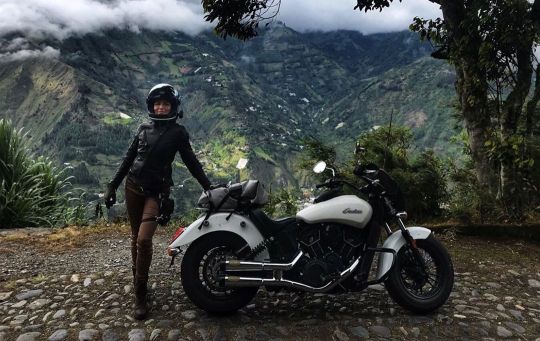
On the road to Lou Jost’s orchid research shire habitat and the currently sleeping Tungurahua volcano. . Ecuador is home to more than 4000 unique plant species found nowhere else in the world; many of these are threatened by the rapid deforestation taking place. . The habitat degradation that follows deforestation threatens not only the plants and wildlife but the well-being of the human population, causing an exodus to urban areas and an accompanying loss of dignity. . Lou Jost and a group of concerned scientists and conservationists started a foundation to do something to save the threatened organisms of Ecuador's forests, and at the same time ensure that the local people find a dignified and sustainable livelihood. . If you’re traveling to Baños, Ecuador, consider staying with a host family in the nearby village of El Placer. Not only will you have an authentic experience with some truly wonderful people, but you will be furthering conservation efforts by bringing income to a community who is committed to protecting the marvelous nature around them. . Contact EcoMinga for more information or just show up in the village. They rotate turns for homestay throughout the community so that they all have an opportunity to host. . 📸 by @sugarkneesandy . @indianmotorcycle @rolandsandsdesign . #ecominga #conservation #ecuador #bañosecuador #scoutsixty #indianmotorcycle #womenwhoride #rolandsandsdesign #miajacket https://www.instagram.com/p/B8ZJxKCBKRr/?igshid=n4buzbam47qq
#ecominga#conservation#ecuador#bañosecuador#scoutsixty#indianmotorcycle#womenwhoride#rolandsandsdesign#miajacket
1 note
·
View note
Text
Just signed up to #RunfortheRainforest with Reserva: The Youth Land Trust this year! It’s their 3rd annual virtual charity run (5km + a 1 mile dash) - you can run, walk, or do whatever you want.
“This emergency, youth-led project in Ecuador will protect at least 11 highly threatened species in a 1,050-acre area still almost entirely unexplored by scientists.
In addition to helping assemble a critical wildlife corridor as part of the Dracula Reserve network, this project will quintuple the size of Dracula Youth Reserve—the world's first entirely youth-funded nature reserve, which was established in 2021 between Reserva, Rainforest Trust, and Fundación EcoMinga. Donations to this campaign will enable our Ecuadorian partner, EcoMinga, to purchase and protect this land in perpetuity, conserving a Key Biodiversity Area and critical clean drinking water resources for local and Indigenous communities.”
A donor is currently matching registrations $5 up to the first 1000 sign ups - you can do so here (or just have a look) if you’re interested!
40 notes
·
View notes
Text

WORM FIGHT

Photocredit: Luis and Fausto Recalde/ EcoMinga
9 notes
·
View notes
Text
New Species Named After DAO That Funds Conservation - ZellaNews
New Species Named After DAO That Funds Conservation – ZellaNews
Glass frog DAO: A decentralized autonomous group that protects the rainforest has a newly found frog named after it. Several thousand acres of pristine cloud forest within the Choco bioregion of northwestern Ecuador have been preserved. This is because of the Rainforest Trust, alongside Ecuadorian accomplice Fundacion Ecominga. The cloud forest is a hotspot for its variety of orchids and…

View On WordPress
0 notes
Text
Scientists investigate biodiversity in Ecuador’s Llanganates
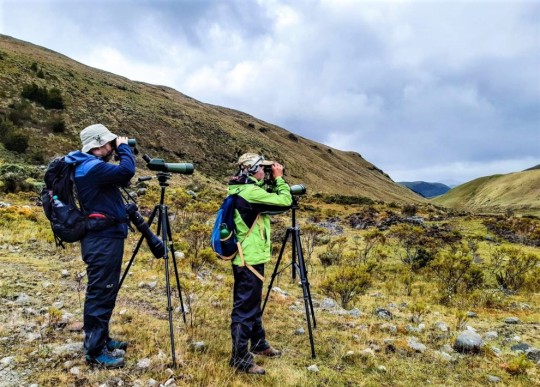
Biodiversity loss is one of the biggest challenges nature faces. In the context of examining man-made changes in the environment, scientists studied flora and fauna in Ecuador. Llanganates, the Cloud Forest and Finca Palmonte gave them valuable insights. They discussed their findings in a meeting with local professors.
Anthropogenic impact on biodiversity and landscape change
Humans put their mark on planet earth. Greenhouse gas emissions, plastic pollution and biodiversity loss are our footprints in the world. That is the topic of the Expedition Anthropocene: Six German scientists from Die Junge Akademie came to Ecuador in order to research the human’s impact on its environment. Apart from studying the glacier retreat and climate change in Ecuador the team also addressed the country’s biodiversity and landscape change. Biologist Christian Hof wants to find out how biodiversity differs between anthropogenic and natural places at different altitudes. Due to its wide variety of flora and fauna and its different levels of height Ecuador is the perfect location for this research. Additionally, the scientists want to see how humans changed the landscape. Therefore, the team went to one of the most impressive locations of Ecuador: The Llanganates national park.

© Die Junge Akademie - Expedition Team
The Llanganates national park
A sense of mystery and adventure encases the Llanganates national park. On one hand that’s because of its inaccessible terrain. It consists of forests and moorlands. Fog often veils the scenery. On the other hand it’s because a legend tells that the Incas hid a huge treasure of gold and silver artifacts in Llanganates. It says that the Inca general Rumiñahui wanted to use the riches to ransom his king Atahualpa. However, he concealed the treasure after hearing that Atahualpa was killed. Lots of adventurers who came to Llanganates filled with hope to find the treasure eventually got lost in the confusing topography. The real treasure of Llanganates is probably its magic scenery and biodiversity. The vegetated mountainous landscape is the habitat of various plants and animals. In Llanganates you feel like you are in another world. Llanganates is divided into two zones: western and eastern. The western zone is a deserted landscape with mountains and high valleys. The eastern one is known for its rich biodiversity. However, this area is very hard to access. That’s the reason why the biodiversity of Llanganates has been studied very little.

© Die Junge Akademie - Expedition Team
Research in Llanganates
Medical doctor Martin-Immanuel Bittner performs a qualitative study regarding the local population's perception of climate and climate change. In this context, he conducted a range of interviews with inhabitants of the Llanganates area, including a ranger of the national park. In addition, Christian Hof observed the birds of the reservoir together with the Ecuadorian ornithologist Carlos Díaz. They were able to spot some interesting species. The conservation rules in Llanganates are very strict. Nevertheless, nature suffers from illegal wildlife hunting, extraction of timber and progressing agriculture. As a result, the group saw radical changes in the landscape. A big part of the terrain that is naturally occupied by woods was transformed for farming.

© Die Junge Akademie - Expedition Team The scientists also visited another part of Llanganates: The Cloud Forest. This jungle in Ecuador is known for its huge biodiversity. Although the Cloud Forest occupies only a tiny part of the world’s surface, it’s the habitat of a big proportion of all existing bird species. Where does that diversity come from? First, from the climatic conditions in Ecuador. Second, the jungle stands on a slope. That allows the sunrays to come deeper into the forest and support a larger variety of life forms. For biologist and bird expert Christian Hof the Cloud Forest was ideal to study Ecuador’s diverse flora and fauna.

© Die Junge Akademie - Expedition Team
Cooperation with local university
An important part of scientific progress is the exchange of knowledge with other experts. That’s why the members from Expedition Anthropocene met professors from their official partner: The Universidad Estatal Amazónica in Puyo. Together with Andean Summit Adventure the university organized the application for the national park permits. Moreover, it supported the expedition team by sharing their research and understanding of Ecuador’s environment. At a meeting at the hotel La Chimenea in Baños de Agua Santa the scientists talked about several topics. Some of them were the observed glacier retreat of Chimborazo, immense plastic usage and the resulting pollution and Ecuador’s biodiversity. Besides, they discussed further collaboration for the interpretation of the collected data. In addition, the expedition team also met researches from the Universidad Católica del Ecuador and Universidad San Francisco de Quito to discuss their observations. As a result, the close collaboration will allow the scientists to put their findings on climate and land-use change in a wider context.

© Die Junge Akademie - Expedition Team
Investigations at Finca Palmonte
Even after having seen the incredible nature of Llanganates and the Cloud Forest, the Finca Palmonte in the CELS (Corridor Ecológico Llanganates Sangay) impressed the scientists. The name “Palmonte” is derived from the palm trees and mountains that surround the finca. This isolated place in the middle of nowhere was perfect for the expedition´s research. The team studied colorful butterflies, birds, orchids and interesting insects. Moreover, they spoke to Fausto Recalde from the EcoMinga Foundation about how climate change affects the Candelaria Reserve. Besides, Dirk Pflüger used the opportunity to take panoramic photos in order to analyse the different forms of landscape.
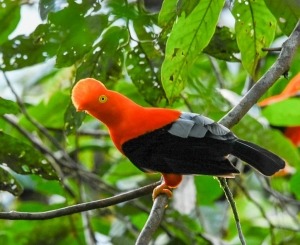
© Die Junge Akademie - Expedition Team
Humans and the environment
Humans are a strange species. We exist on this planet for a relatively short amount of time. Nonetheless, we dramatically changed the world. That presents nature with heavy challenges. As our lives are embedded into the environment, we depend on it. Thus, it’s in our best interest to conserve it. The Expedition Anthropocene did a lot of research in Ecuador. Packed with glacier samples, photos from flora and fauna, answers from the interviews and good relationships to local professors the team of scientists returns to Germany. Back home the analysis of the collected data starts. Being aware of the importance that the environment has for us, Andean Summit Adventure hopes that the results from Expedition Anthropocene help in the process of protecting nature. All Photos: © Die Junge Akademie - Expedition Team Read the full article
0 notes
Photo

Ecuadorean Reserve Expanded to Safeguard Cloud Forest
An additional land purchase of 126 acres brings Río Zuñac Reserve’s total size to over 2,400 acres, protecting pristine cloud forest, endangered and range-restricted orchids and other threatened species. Rainforest Trust’s Ecuadorean partner Fundación EcoMinga has purchased a 126-acre property...
0 notes
Video
Sigmatostalix sp. by Andreas Kay Via Flickr: from Rio Machay Reserve, Ecuador: ecomingafoundation.wordpress.com/2016/04/14/exploring-the...
19 notes
·
View notes
Video
Clusia sp., Clusiaceae by Andreas Kay Via Flickr: from Rio Machay Reserve, Ecuador: ecomingafoundation.wordpress.com/2016/04/14/exploring-the...
2 notes
·
View notes
Photo

Just some of the new species of Teagueia orchids discovered by Lou Jost and his team in central-eastern Ecuador. . The evolutionary radiation of these orchids is extraordinary, containing double the number of species of the famous Galapagos radiations, even though the Galápagos Islands are much bigger than the four mountains these orchids were found on, and far more isolated. . What’s perplexing is that orchid dispersal is ridiculous; they have the smallest seed of any flowering plant, which can disperse more than 800km. . That’s why even in the Galapagos, there are almost no endemic orchids... the vast majority have arrived from mainland Ecuador. . Therefore, the notion that this number and variety of orchid species evolved in such close proximity—on adjacent mountaintops— is mysterious. . With the discovery of this evolutionary radiation, how many more species of orchids might be hidden on mountaintops, in plain sight? . One single mountain in Ecuador had 16 new species of orchids, which are currently the subject of several ecological and evolutionary studies, as this is an unprecedented local speciation event. . Thanks to EcoMinga, and support from the World Land Trust, they’ve been able to preserve these unique, orchid-filled mountain peaks for posterity. . @worldlandtrust #ecominga . #evolution #adaptiveradiation #ecology #botany #orchids #worldlandtrust #mysterious #teagueia #loujost #paradise #ecuador #tropics #tesoros #darwin #galapagos #conservation #worldlandtrust https://www.instagram.com/p/CAdLAAohGvQ/?igshid=1frn17t0vvt0c
#ecominga#evolution#adaptiveradiation#ecology#botany#orchids#worldlandtrust#mysterious#teagueia#loujost#paradise#ecuador#tropics#tesoros#darwin#galapagos#conservation
0 notes
Photo
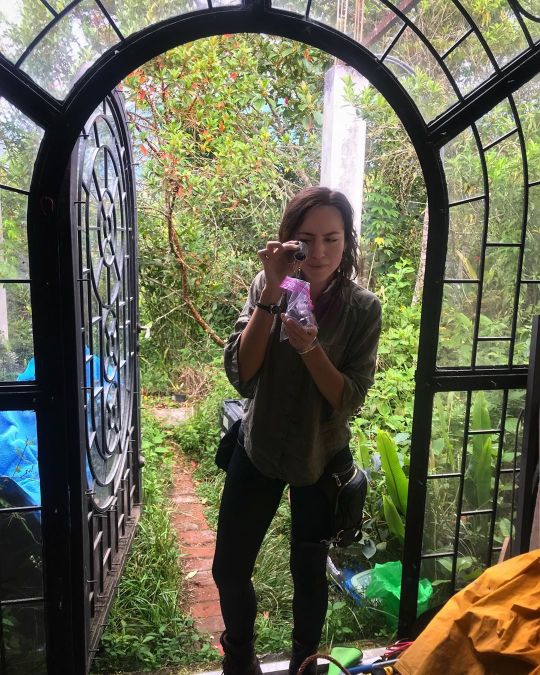
“I'd like to introduce you to the hidden world of micro-orchids” he said. . Traveling up the slope of the Tungurahua volcano, I arrived at Lou Jost’s home, which felt more like a research laboratory tucked into the shire. . More than 8,000 orchid-filled vials covered the shelves and part of the floor in his home— specimens used to describe the 65+ new species of orchids to science in the past 15 years. . By accident, Jost discovered the smallest orchid on the planet (2.1 mm wide). The flowers of this orchid are so tiny that its petals are just one cell thick and transparent. . #ecominga #microorchids #orchids #biodiversity #scoutsixty https://www.instagram.com/p/CAaq5_thcp5/?igshid=mx2kq1tetuar
0 notes
Photo

This photo represents an abundance of gratitude for me. . I’m grateful that a serendipitous moment led me to learning about Lou Jost’s work, that I got to trek into one of the reserves he, and the team at EcoMinga, created, and that I got to attend his class on the Mathematics of Biodiversity in Quito, before the pandemic swept its way across the globe. . With a background in physics and mathematics, Jost is not a typical biologist. Seeing the cloud forests of Ecuador and their unparalleled species richness, Jost realized that the conventional way of measuring diversity and comparing it between different sites was doing a major disservice to the true complexity of the many species which live in the tropical Andes. . What is needed is a shift in the way ecological sciences are quantified, to break free of this needless cycle, as it does not substitute for real measures of effect size and is rarely the appropriate model for valid research. We should move to methods where questions are designed in terms of estimating meaningful parameters and statically uncertainties are expressed in confidence intervals, rather than testing an always-false null hypothesis and determining an arbitrary p-value. . Cheers to moving away from inefficient and even harmful practices, simply because they are what we’ve always done in the past. . #ecominga #loujost #mathematics of #biodiversity #ecology #biology #diversity #serendipity #stem #gratitude https://www.instagram.com/p/CAQSnEjhVUg/?igshid=16jj43ctbzt35
0 notes
Photo

When we die, the collection of very particular experiences and thoughts— not just the collection but the selection that we’ve somehow pulled together, rescued from the flotsam and jetsam of our own lives and made into our own story of who we are— that will be gone. And it will never be replaced. This makes up who we are and what is lost when we die. • I paraphrased these words from what Jenann Ismael said while talking to Sean Carroll on his Mindscape podcast. • I feel this is a very poignant description of why loss hurts so much— whether a loved one dies or a relationship ends, it is not just the present moments we have to say goodbye to, but their past and futures, all that they were and all they could be. • It seems the answer is to look to gratitude for the moments we shared, the lessons, and of course, the love. • Jenann Ismael is a badass. Her research focuses on the philosophy of physics and metaphysics, especially areas involving the structure of space and time, quantum mechanics, and the foundations of physical laws. • This peaceful moment immersed in the sounds of the river and birds was in EcoMinga’s Rio Zuñac reserve, a place that I am so thankful will be protected—for all the inhabitants who live there. • @seanmcarroll #jenannismael #metaphysics #philosophy #mindscape #physics #ecominga #conservation #loss #wearealltrulywild #flotsamandjetsam https://www.instagram.com/p/B8JrP4uB80j/?igshid=ucs6g65jov8
#jenannismael#metaphysics#philosophy#mindscape#physics#ecominga#conservation#loss#wearealltrulywild#flotsamandjetsam
0 notes
Photo
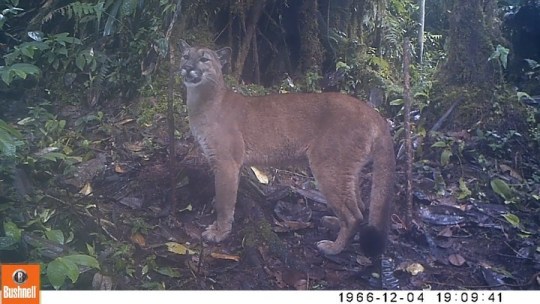
EcoMinga’s camera trap footage from their Dracula Reserve in NW Ecuador. • *I put these videos out of order so that you might guess what this healthy female puma (Felis concolor) is so interested in. • The following clip shows a well-fed male making a scent mark right in front of the camera. This is the same male that the EcoMinga Foundation had filmed in their earlier operation, confirming the need for an ecological corridor between existing reserves. • I love seeing this distant communication, of interpreting scent chemicals, and the face the female makes while she (perhaps) analyzes what it is this particular fragrance is telling her. • EcoMinga is doing amazing things in Ecuador and has a captivating blog to tell the story. They are currently too cool for Instagram so you’ll have to find them elsewhere. • #draculaorchids #ecominga #puma #felisconcolor #longdistancerelationship #ecuador #wildlifeconservation #cameratraps #bushnell (at Ecuador) https://www.instagram.com/p/B7l_09tBKit/?igshid=103bkzo4nfku8
#draculaorchids#ecominga#puma#felisconcolor#longdistancerelationship#ecuador#wildlifeconservation#cameratraps#bushnell
0 notes
Photo

I guess this is my birthday suit! . If there’s anything I’ve learned in this most recent revolution around the sun, its that being alive is a privilege. For many years, I believed quite the opposite, and the weight of collective suffering around the world - especially of those without a voice - crushed me. . My path became very clear at that point — one of action. . From then on, I’ve been creating education curriculum for children to help the plight of our planet’s flora and fauna, I’ve been sharing the stories of those on the frontlines of conservation, providing technical support to wildlife protection organizations, raising awareness through my writing, and doing all of it while living on a motorcycle. . This year has been incredibly different, as I’m riding the most amazing machine I’ve ever been on, my gear has significantly improved (hello @SENA bluetooth helmet camera and RSD waterproof boots!), and I’m even getting paid for my writing (I’ve been doing this all for free for many years). . Even though I’m solo on this journey, I feel incredibly supported by those who believe in me and for this I’m immensely grateful. . To have all of these cells working together, these molecules arranged just so, these atoms working in ways which are still mysterious to us - all making up this living vessel my soul moves around the earth on is truly wild. This existence is highly improbable and therefore being alive is a tremendous privilege. . Photo taken in EcoMinga’s Rio Zuñac reserve by Tito, a “Keeper of the Wild.” . Thanks to: @rolandsandsdesign @rolandsands @indianmotorcycle @indianmotorcyclechile @senabluetooth @giantloopmoto @memphisshades . @worldlandtrust #ecominga #orchidconservationalliance . And everyone who’s been rooting for me along the way. . Cheers to hurling through space on this beautiful planet we call home. 🥂🌿🌙🐅 https://www.instagram.com/p/B7dvCMfhXw9/?igshid=10aobhtb76tm0
0 notes
Photo
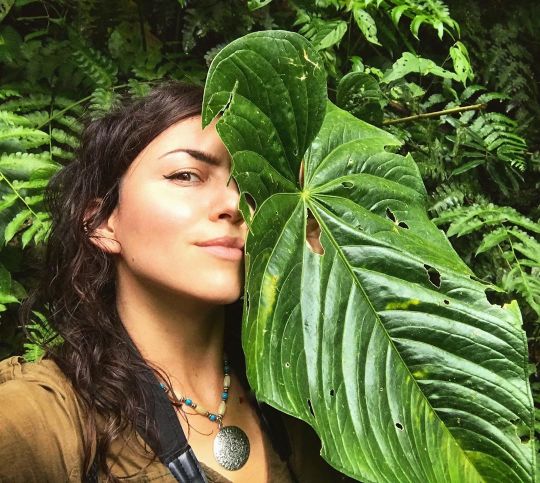
Heading to a biological research station deep within a reserve where there are rare orchids, incredible birds, and where the scientists and the “Keepers of the Wild” found at least one spectacled bear sleeping in their beds. . I’ll be out of reach for a few days. . #EcoMinga #ecuador @wwfecuador @rainforesttrust #rainforest #conservation #wild https://www.instagram.com/p/B7QpruWBeaa/?igshid=1p40biz6li4kp
0 notes